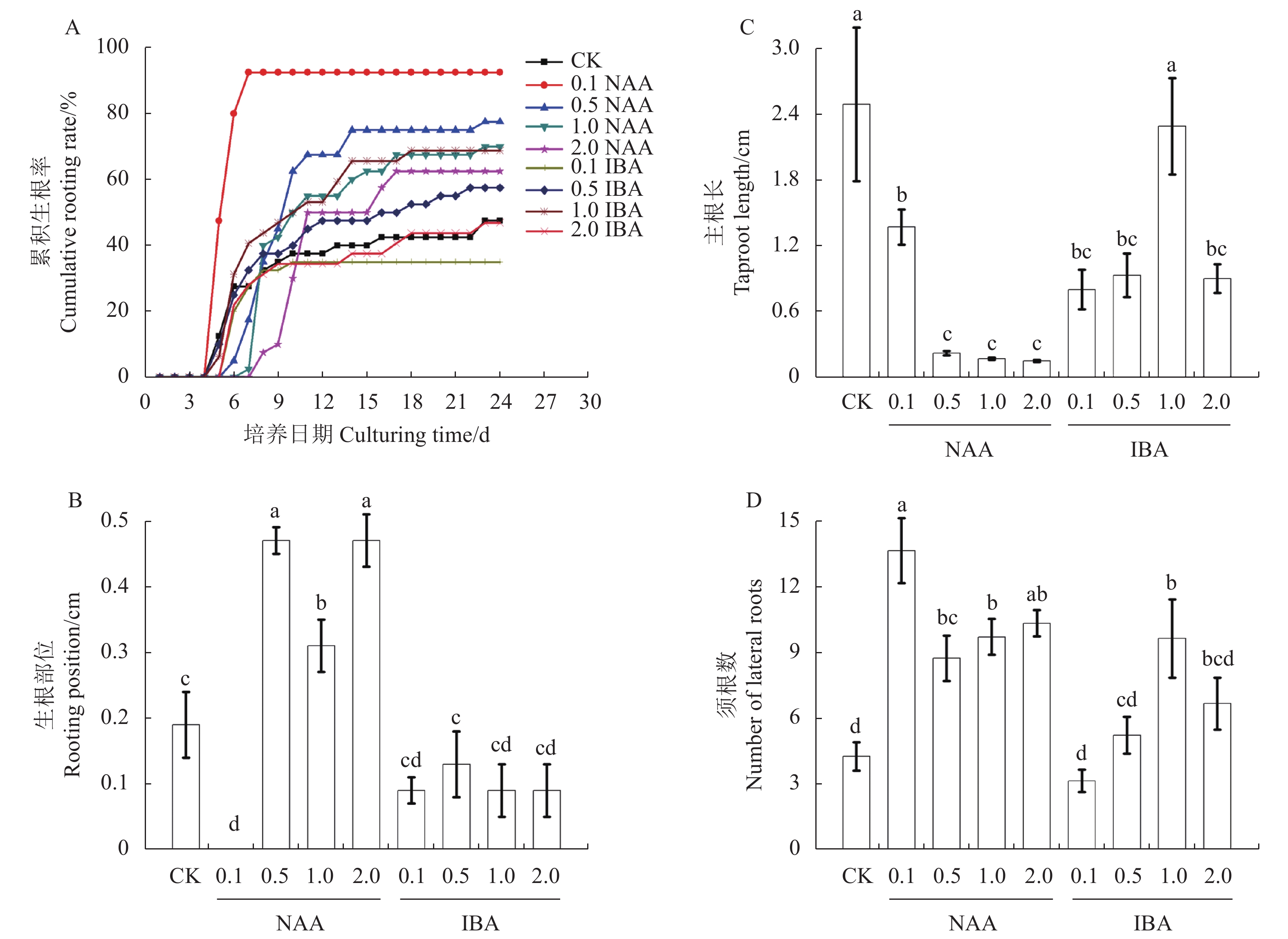Optimization of Seed Sterilization and Rooting Medium for Regeneration of Brassica napus
-
摘要:
目的 植物的种子灭菌和生根培养是组织培养的重要步骤。目前已报道的用于甘蓝型油菜种子灭菌的次氯酸钠(NaClO)浓度、灭菌时间和生根培养基的植物生长调节剂种类及其浓度均存在较大的差异,因此,本研究旨在筛选出甘蓝型油菜种子的最佳NaClO灭菌处理方法和生根培养基最适的植物生长调节剂及其浓度。 方法 比较了甘蓝型油菜的种子经不同浓度(浓度范围为0.1% ~ 30.0%)NaClO灭菌后的发芽率、健康芽率和菌落率,筛选出最适的种子灭菌NaClO浓度,再在该最适NaClO浓度基础上找出了最适的种子灭菌时间;通过比较不同质量浓度(0.1 ~ 2.0 mg·L−1)的植物生长调节剂萘乙酸(NAA)或吲哚丁酸(IBA)对甘蓝型油菜再生根的促进作用,找出油菜生根培养最适的植物生长调节剂种类及其浓度。 结果 甘蓝型油菜种子的最佳灭菌NaClO浓度为2.0%或3.0%,在3.0% NaClO下的最适灭菌时间为15 min,种子经该灭菌方法处理后的发芽率和健康芽率分别可达97.4%和85.9%,且菌落发生率最少。该油菜种子灭菌的方法也适用于其他9个植物品种,尤其适合于甘蓝型油菜、大白菜和拟南芥的种子灭菌。在生根培养基中添加0.1 mg·L−1 NAA对甘蓝型油菜再生根的促进作用最强,油菜培养7 d后即有92.5%的累积生根率,再生根从切点处生长,且再生的须根数最多。 结论 本研究优化了甘蓝型油菜种子的NaClO灭菌方法和生根培养基的植物生长调节剂及其浓度,为高效的油菜组织培养研究奠定了基础。 Abstract:Objective Seed sterilization and rooting culture are important steps in plant tissue culture. At present, there is considerable variation in the concentration of sodium hypochlorite (NaClO) and seed sterilization time of Brassica napus, as well as the type and concentration of hormone in the rooting media. The purpose of this study was to optimize the method of seed sterilization with NaClO and the formula of rooting medium for B. napus regeneration. Method The optimum concentration of NaClO for seed sterilization was screened by comparing the growth status (such as germination rate, healthy shoot rate and rate of colonies) of seeds treated with different concentrations (0.1%–30.0%) of NaClO, and the appropriate sterilization time was optimized based on the growth status of seeds treated with the optimal concentration of NaClO for 10—30 min. Moreover, the optimum formula of rooting media was screened by comparing the rooting regeneration of seedlings in the media containing 0.1–2.0 mg·L−1 naphthylacetic acid (NAA) / indolebutyric acid (IBA). Result The optimum concentration of NaClO for seed sterilization was 2.0% or 3.0%, and the best time for seed sterilization with 3.0% NaClO was 15 min, causing the 97.4% of germination rate and 85.9% of healthy shoot rate with least rate of colonies. Moreover, this method of seed sterilization is applicable to other 9 plants, especially for B. napus, B. pekinensis and Arabidopsis thaliana. The root regenerated best in the rooting medium containing 0.1 mg·L−1 NAA, in which 92.5% of root regenerated from the cutting point on the 7th day with the most lateral roots. Conclusion This study optimized the method of seed sterilization and the formula of rooting medium, which laid a foundation for efficient plant tissue culture of B. napus. -
Key words:
- Brassica napus /
- seed sterilization /
- sodium hypochlorite /
- rooting /
- NAA /
- IBA
-
图 1 甘蓝型油菜种子灭菌的NaClO大范围浓度初步筛选
注:A, 发芽率; B, 健康芽率; C, 菌落率。同一图中的不同字母表示处理间具有显著性差异(P ≤ 0.05),数值表示“平均值 ± 标准误”。图2~3同。
Figure 1. Preliminary screening of large-scale concentration of NaClO for seed sterilization in B. napus
Note: A, germination rate; B, healthy shoot rate; C, rate of colonies. Different lowercase letters represent significant difference between treatments (P ≤ 0.05), the value means “mean ± standard error”. The same as Fig.2~3.
图 4 种子灭菌方法对其他芸苔属作物种子的灭菌效果
注:A, 发芽率;B,健康芽率;C,菌落率;D,9种植物品种的种子;E,9种植物品种的种子灭菌7 d后的苗生长情况。JF,甘蓝B. oleracea ‘京丰一号’;HC,白菜型油菜B. compestris ‘红菜苔’;XZ,小白菜B. campestris ‘夏尊’;YK,甘蓝型油菜B. napus ‘亚科油68’;GY,甘蓝型油菜B. napus ‘高油605’;DF,甘蓝型油菜B. napus ‘德丰油’;ZS,大白菜B. pekinensis ‘F1早熟五号’;SC,莴苣Lactuca sativa ‘意大利全年生菜王’;AT,拟南芥Arabidopsis thaliana。同一小图中的不同字母表示处理间有显著性差异(P ≤ 0.05),数值表示“平均值 ± 标准误”。
Figure 4. The effects of seed sterilization for other Brassica crops with the screened optimal method
Note: A, germination rate; B, healthy shoot rate; B, rate of colonies; D, seeds of 9 plant species; E, seedling growth status of 9 plant species after seed sterilization and sowing for 7 days. JF (B. oleracea ‘Jing Feng 1’), HC (B. compestris ‘Hong Cai Tai’), XZ (B. campestris ‘Xia Zun’), YK (B. napus ‘Ya Ke’), GY (B. napus ‘Gao You’), DF (B. napus ‘De Feng’), ZS (B. pekinensis ‘Zao Shou 5’), SC (Lactuca sativa) and AT (Arabidopsis thaliana). Different lowercase letters represent significant difference between treatments (P ≤ 0.05), the value means “mean ± standard error”.
图 5 不同质量浓度NAA/IBA对油菜再生根的累积生根率、生根部位、主根长和须根数的影响
注:A、累积生根率;B、生根部位(再生根位置与切点处之间的距离);C、主根长;D、须根数。CK、培养基内未添加植物植物生长调节剂; 0.1 NAA, 0.1 mg·L−1 NAA; 0.5 NAA, 0.5 mg·L−1 NAA; 1.0 NAA, 1.0 mg·L−1 NAA; 2.0 NAA, 2.0 mg·L−1 NAA; 0.1 IBA, 0.1 mg·L−1 IBA; 0.5 IBA, 0.5 mg·L−1 IBA; 1.0 IBA, 1.0 mg·L−1 IBA; 2.0 IBA, 2.0 mg·L−1 IBA。图中的不同字母表示处理间具有显著性差异(P ≤ 0.05),数值表示“平均值 ± 标准误”。
Figure 5. Effects of different concentrations of NAA / IBA on cumulative rooting rate, rooting position, taproot length and number of lateral roots of regenerative roots of B. napus
Note: A, cumulative rooting rate; B, rooting position (the distance between root regenerated position and cut point); C, number of lateral roots; D, taproot length. CK, media without plant hormone; 0.1 NAA, 0.1 mg·L−1 NAA; 0.5 NAA, 0.5 mg·L−1 NAA; 1.0 NAA, 1 mg·L−1 NAA; 2.0 NAA, 2.0 mg·L−1 NAA; 0.1 IBA, 0.1 mg·L−1 IBA; 0.5 IBA, 0.5 mg·L−1 IBA; 1.0 IBA, 1.0 mg·L−1 IBA; 2.0 IBA, 2.0 mg·L−1 IBA. Different lowercase letters represent significant difference between treatments (P ≤ 0.05), the value means “mean ± standard error”.
-
[1] OYEBANJI O, NWEKE O, ODEBUNMI O, et al. Simple, effective and economical explant-surface sterilization protocol for cowpea, rice and sorghum seeds [J]. African Journal of Biotechnology, 2009, 8(20): 5395−5399. [2] YILDIZ M, EKIZ H. The effect of sodium hypochlorite solutions on in vitro seedling growth and regeneration capacity of sainfoin (Onobrychis viciifolia Scop.) hypocotyl explants [J]. Canadian Journal of Plant Science, 2014, 94(7): 1161−1164. doi: 10.4141/cjps2013-250 [3] 郝梦宇, 丁炳莉, 李超, 等. 甘蓝型油菜组培苗生根培养体系的优化 [J]. 中国油料作物学报, 2018, 40(3):352−358. doi: 10.7505/j.issn.1007-9084.2018.03.006HAO M Y, DING B L, LI C, et al. Optimization of rooting medium for in vitro transgenic shoots in Brassica napus [J]. Chinese Journal of Oil Crop Sciences, 2018, 40(3): 352−358.(in Chinese) doi: 10.7505/j.issn.1007-9084.2018.03.006 [4] ZIAEI M, MOTALLEBI M, ZAMANI M R, et al. Co-expression of chimeric chitinase and a polygalacturonase-inhibiting protein in transgenic canola (Brassica napus) confers enhanced resistance to Sclerotinia sclerotiorum [J]. Biotechnology Letters, 2016, 38(6): 1021−1032. doi: 10.1007/s10529-016-2058-7 [5] BHALLA P L, SINGH M B. Agrobacterium-mediated transformation of Brassica napus and Brassica oleracea [J]. Nature Protocols, 2008, 3(2): 181−189. doi: 10.1038/nprot.2007.527 [6] RADKE S E, ANDREWS B M, MOLONEY M M, et al. Transformation of Brassica napus L. using Agrobacterium tumefaciens: developmentally regulated expression of a reintroduced napin gene [J]. Theoretical and Applied Genetics, 1988, 75(5): 685−694. doi: 10.1007/BF00265588 [7] FAN Y, DU K, GAO Y, et al. Transformation of LTP gene into Brassica napus to enhance its resistance to Sclerotinia sclerotiorum [J]. Russian Journal of Genetics, 2013, 49(4): 380−387. doi: 10.1134/S1022795413040042 [8] SONNTAG K. Genotype and procedure dependence of Agrobacterium-mediated transformation of Brassica napus [J]. Journal of Consumer Protection and Food Safety, 2007, 2(1): 113. [9] ENGELKE T, HIRSCHE J, ROITSCH T. Metabolically engineered male sterility in rapeseed (Brassica napus L.) [J]. Theoretical and Applied Genetics, 2011, 122(1): 163−174. doi: 10.1007/s00122-010-1432-4 [10] KONG F, LI J, TAN X, et al. New time-saving transformation system for Brassica napus [J]. African Journal of Biotechnology, 2009, 8(11): 2497−2502. [11] WANG Y Q, ZHANG Y, WANG F, et al. Development of transgenic Brassica napus with an optimized cry1C* gene for resistance to diamondback moth (Plutella xylostella) [J]. Canadian Journal of Plant Science, 2014, 94(8): 1501−1506. doi: 10.4141/cjps-2014-099 [12] LIU H B, GUO X, NAEEM M S, et al. Transgenic Brassica napus L. lines carrying a two gene construct demonstrate enhanced resistance against Plutella xylostella and Sclerotinia sclerotiorum [J]. Plant Cell, Tissue and Organ Culture, 2011, 106(1): 143−151. doi: 10.1007/s11240-010-9902-6 [13] ELHITI M, YANG C, CHAN A, et al. Altered seed oil and glucosinolate levels in transgenic plants overexpressing the Brassica napus SHOOTMERISTMLESS gene [J]. Journal of Experimental Botany, 2012, 63(12): 4447−4461. doi: 10.1093/jxb/ers125 [14] MCALLISTER C H, WOLANSKY M, GOOD A G. The impact on nitrogen-efficient phenotypes when aspartate aminotransferase is expressed tissue-specifically in Brassica napus [J]. New Negatives in Plant Science, 2016, 3: 1−9. [15] WANG Y, XU H, KOU J J, et al. Dual effects of transgenic Brassica napus overexpressing CS gene on tolerances to aluminum toxicity and phosphorus deficiency [J]. Plant Soil, 2013, 362: 231−246. doi: 10.1007/s11104-012-1289-1 [16] JIANG Y Z, FU X L, WEN M L, et al. Overexpression of an nsLTPs-like antimicrobial protein gene (LJAMP2) from motherwort (Leonurus japonicus) enhances resistance to Sclerotinia sclerotiorum in oilseed rape (Brassica napus) [J]. Physiological and Molecular Plant Pathology, 2013, 82: 81−87. doi: 10.1016/j.pmpp.2012.11.001 [17] KHAN M R, RASHID H, ANSAR M, et al. High frequency shoot regeneration and Agrobacterium-mediated DNA transfer in Canola (Brassica napus) [J]. Plant Cell, Tissue and Organ Culture, 2003, 75(3): 223−231. doi: 10.1023/A:1025869809904 [18] MASHAYEKHI M, SHAKIB A M, AHMADRAJI M, et al. Gene transformation potential of commercial canola (Brassica napus L.) cultivars using cotyledon and hypocotyl explants [J]. African Journal of Biotechnology, 2008, 7(24): 4459−4463. [19] ORLIKOWSKA T, NOWAK K, REED B. Bacteria in the plant tissue culture environment [J]. Plant Cell, Tissue and Organ Culture, 2017, 128(3): 487−508. doi: 10.1007/s11240-016-1144-9 [20] 杜燕, 蒋海玉, 刘其宁. 贮存过期油菜种子消毒方法的研究 [J]. 种子, 2003(2):39−40. doi: 10.3969/j.issn.1001-4705.2003.02.016DU Y, JIANG H Y, LIU Q L. Studies on rescue and propagation of rape germplasm resources exceeding the effective storage duration the collection of sterilization methods [J]. Seed, 2003(2): 39−40.(in Chinese) doi: 10.3969/j.issn.1001-4705.2003.02.016 [21] 耿思宇, 张姗姗, 徐培林, 等. 激素组合等在甘蓝型油菜下胚轴再生中的作用 [J]. 山西农业科学, 2019, 47(5):730−733, 760. doi: 10.3969/j.issn.1002-2481.2019.05.07GENG S Y, ZHANG S S, XU P L, et al. Role of hormone combinations on hypocotyls regeneration in Brassica napus [J]. Journal of Shanxi Agricultural Sciences, 2019, 47(5): 730−733, 760.(in Chinese) doi: 10.3969/j.issn.1002-2481.2019.05.07 [22] 杨长友, 袁中厚, 郑小敏, 等. 甘蓝型油菜高效离体再生体系的建立 [J]. 生物技术通报, 2013(1):111−115.YANG C Y, YUAN Z H, ZHENG X M, et al. Establishment of effective regeneration system of Brassica napus L. in vivo [J]. Biotechnology Bulletin, 2013(1): 111−115.(in Chinese) [23] 黄昌蓉. 甘蓝型油菜早熟基因遗传转化体系的建立及转基因植株初步鉴定[D]. 杭州: 浙江大学, 2013.HUANG C R. Establishment of genetic transformation with earliness gene and preliminary identification of transgenic plant in Brassica napus[D]. Hangzhou: Zhejiang University, 2013. (in Chinese) [24] BIJANZADEH E, NOSRATI K, EGAN T. Influence of seed priming techniques on germination and emergence of rapeseed (Brassica napus L.) [J]. Seed Science and Technology, 2010, 38: 242−247. doi: 10.15258/sst.2010.38.1.26 [25] HATZIG S V, FRISCH M, BREUER F, et al. Genome-wide association mapping unravels the genetic control of seed germination and vigor in Brassica napus [J]. Frontiers in Plant Science, 2015(6): 221. [26] LINDSEY B, RIVERO L, CALHOUN C S, et al. Standardized method for high-throughput sterilization of Arabidopsis seeds [J]. Journal of Visualized Experiments, 2017, 128: e56587. [27] JOVIČIČ D, POPOVIČ B M, JEROMELA A M, et al. The interaction between salinity stress and seed ageing during germination of Brassica napus seeds [J]. Seed Science and Technology, 2019, 47(1): 47−52. doi: 10.15258/sst.2019.47.1.05 [28] HAO Z P, HUANG F, HOU S M, et al. Varietal differences in response to imidacloprid seed treatment in germination and early seedling growth of oilseed rape [J]. Seed Science and Technology, 2019, 47(1): 1−12. doi: 10.15258/sst.2019.47.1.01 [29] MALEK M, GHADERI-FAR F, TORABI B, et al. The influence of seed priming on storability of rapeseed (Brassica napus) seeds [J]. Seed Science and Technology, 2019, 47(1): 87−92. doi: 10.15258/sst.2019.47.1.09 [30] MAGRINI S, VITIS M D. In vitro reproduction of three Limodorum species (Orchidaceae): impacts of scarification methods and nitrogen sources on mature seed germination and seedling development [J]. Plant Biosystems, 2017, 151(3): 419−428. doi: 10.1080/11263504.2016.1179698 [31] YADAV K, SINGH N. Effect of seed harvesting season and sterilization treatments on germination and in vitro propagation of Albizia lebbeck (L.) Benth [J]. Analele Universitatii din Oradea, Fascicula Biologie, 2011, 18(2): 151−156. [32] DING H, FU T J, SMITH M A. Microbial contamination in sprouts: how effective is seed disinfection treatment? [J]. Journal of Food Science, 2013, 78(4): 495−501. doi: 10.1111/1750-3841.12064 -








 下载:
下载:





